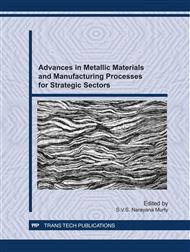[1]
Zhi Lia, Xue-feng Qian, Jie Yina and Zi-kang Zhu, Gold tubes membrane with novel morphology replicated from ZnO template, Journal of Solid State Chemistry. 178 (2005) 1765–1772.
DOI: 10.1016/j.jssc.2005.03.033
Google Scholar
[2]
Ping Wu, Hui Zhang, Ning Du, Lingyan Ruan and Deren Yang, A Versatile Approach for the Synthesis of ZnO Nanorod-Based Hybrid Nanomaterials via Layer-by-Layer Assembly, J. Phys. Chem. C. 113 (2009) 8147–8151.
DOI: 10.1021/jp901896u
Google Scholar
[3]
X. Qun, G. Meng, Y. Zhang, J. Q. Xu, P. C. Xu, Q. Y. Pan and W. J. Yu, Ag nanoparticle embedded-ZnO nanorods synthesized via a photochemical method and its gas-sensing properties, Sens. Actuators B. B143(2) (2010) 635-640
DOI: 10.1016/j.snb.2009.10.007
Google Scholar
[4]
Wei-Qing Zhang, Yang Lu, Tie-Kai Zhang, Weiping Xu, Meng Zhang, and Shu-Hong Yu, Controlled Synthesis and Biocompatibility of Water-Soluble ZnO Nanorods/Au Nanocomposites with Tunable UV and Visible Emission Intensity. J. Phys. Chem. C 112 (2008) 19872–19877.
DOI: 10.1021/jp804547e
Google Scholar
[5]
Djurisic, A. B.; Leung, Y. H. Optical properties of ZnO nanostructures, Small 2 (2006) 944-961.
Google Scholar
[8]
D. C. Look, Recent advances in ZnO materials and devices, Mater. Sci. Eng., B 80 (2001) 383-397.
Google Scholar
[9]
Jiaqiang Xua, Qingyi Panb, Yu'an Shuna, Zhizhuang Tiana, Grain size control and gas sensing properties of ZnO gas sensor, Sensors and Actuators B. 66 (2000) 277-279.
DOI: 10.1016/s0925-4005(00)00381-6
Google Scholar
[10]
Dang Hyok Yoon, Gyeong Man Choi, Microstructure and CO gas sensing properties of porous ZnO produced by starch addition, Sensors Actuators B. 45 (1997) 251-257.
DOI: 10.1016/s0925-4005(97)00316-x
Google Scholar
[11]
Yong-hong Ni , Xian-wen Wei , Jian-ming Hong,Yin Ye, Hydrothermal preparation and optical properties of ZnO nanorods, Materials Science and Engineering B 121 (2005) 42–47.
DOI: 10.1016/j.mseb.2005.02.065
Google Scholar
[12]
U. Diebold, L. V. Koplitiz, O. Dulub, Atomic-scale properties of low-index ZnO surfaces, Appl. Surf. Sci. 237 (2004) 336-342.
DOI: 10.1016/s0169-4332(04)00985-7
Google Scholar
[13]
Xin Wang, Xianggui Kong, Yi Yu, and Hong Zhang, Synthesis and Characterization of Water-Soluble and Bifunctional ZnO−Au Nanocomposites, J. Phys. Chem. C. 111 (2007) 3836-3841.
DOI: 10.1021/jp064118z
Google Scholar
[14]
Y. Liu, M. Zhong, G. Shan, Y. Li, B. Huang, G. Yang, Biocompatible ZnO/Au Nanocomposites for Ultrasensitive DNA Detection Using Resonance Raman Scattering, J. Phys. Chem. B 112 (2008) 6484-6489.
DOI: 10.1021/jp710399d
Google Scholar
[15]
Zhouhua Luan, Jay A Fournier, Jan B. Wooten, Donald E. Miser, Preparation and characterization of (3-aminopropyl)triethoxysilane-modified mesoporous SBA-15 silica molecular sieves, Microporous and Mesoporous Materials 83 (2005) 150–158.
DOI: 10.1016/j.micromeso.2005.04.006
Google Scholar
[16]
Wei Ang, Wang Zhao, Pan Liu-Hua, Li Wei-Wei, Xiong Li, Dong Xiao-Chen, Huang Wei, Room-Temperature NH3 Gas Sensor Based on Hydrothermally Grown ZnO Nanorods, CHIN. PHYS. LETT. 28, 8 (2011) 080702 1-4.
DOI: 10.1088/0256-307x/28/8/080702
Google Scholar
[17]
A. Kolmakov, Y. Zhang, G. Cheng and M. Moskovits, Detection of CO and O2 using tin oxide nanowires sensors, Adv. Mater. 15 (2003) 997-1000.
DOI: 10.1002/adma.200304889
Google Scholar
[18]
V. R. Shinde T. P. Gujar , C. D. Lokhande , R. S. Maneb, Sung-Hwan Han, Use of chemically synthesized ZnO thin film as a liquefied petroleum gas sensor, Materials Science and Engineering B 137 (2007) 119–125.
DOI: 10.1016/j.mseb.2006.11.008
Google Scholar
[19]
Fang-Tso Liu, Shiang-Fu Gao, Shao-Kai Pei, Shih-Cheng Tseng, Chin-Hsin J. Liu, ZnO nanorod gas sensor for NO2 detection, Journal of the Taiwan Institute of Chemical Engineers 40 (2009) 528–532.
DOI: 10.1016/j.jtice.2009.03.008
Google Scholar


